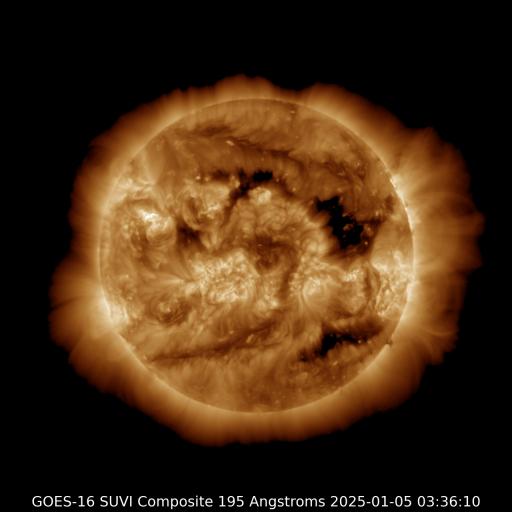Viewing archive of Saturday, 12 October 2024
Solar activity report
Report of Solar-Geophysical Activity 2024 Oct 12 2200 UTCPrepared by the NOAA © SWPC and processed by SpaceWeatherLive.com
Joint USAF/NOAA Report of Solar and Geophysical Activity
SDF Number 286 Issued at 2200Z on 12 Oct 2024IA. Analysis of Solar Active Regions and Activity from 11-2100Z to 12-2100Z
Solar activity has been at low levels for the past 24 hours.
The largest solar event of the period was a C9 event observed at
11/2320Z from Region 3842 (S13, L=181). There are currently 5 numbered
sunspot regions on the disk.
IB. Solar Activity Forecast
Solar activity is likely to be moderate
with a chance for X-class flares on days one, two, and three (13 Oct, 14
Oct, 15 Oct).
IIA. Geophysical Activity Summary 11-2100Z to 12-2100Z
The geomagnetic
field has been at quiet to minor storm levels for the past 24 hours.
Solar wind speed reached a peak of 853 km/s at 12/0830Z. Total IMF
reached 11 nT at 11/2217Z. The maximum southward component of Bz reached
-6 nT at 12/0943Z. Electrons greater than 2 MeV at geosynchronous orbit
reached a peak level of 432 pfu.
IIB. Geophysical Activity Forecast
The geomagnetic field is expected
to be at quiet to active levels on days one, two, and three (13 Oct, 14
Oct, 15 Oct). Protons have a slight chance of crossing threshold on days
one, two, and three (13 Oct, 14 Oct, 15 Oct).
III. Event Probabilities 13 Oct to 15 Oct
| Class M | 55% | 55% | 55% |
| Class X | 25% | 25% | 25% |
| Proton | 15% | 15% | 15% |
| PCAF | green | ||
IV. Penticton 10.7 cm Flux
Observed 12 Oct 214 Predicted 13 Oct-15 Oct 215/210/210 90 Day Mean 12 Oct 223
V. Geomagnetic A Indices
Observed Afr/Ap 11 Oct 068/112 Estimated Afr/Ap 12 Oct 016/024 Predicted Afr/Ap 13 Oct-15 Oct 011/012-009/010-011/012
VI. Geomagnetic Activity Probabilities 13 Oct to 15 Oct
| A. Middle Latitudes | |||
|---|---|---|---|
| Active | 30% | 30% | 30% |
| Minor storm | 05% | 05% | 10% |
| Major-severe storm | 01% | 01% | 01% |
| B. High Latitudes | |||
|---|---|---|---|
| Active | 15% | 15% | 15% |
| Minor storm | 30% | 30% | 30% |
| Major-severe storm | 35% | 35% | 40% |
All times in UTC
Latest news
Latest forum messages
Incoming & Unnumbered Active Regions 1673AR 4054 21AR4048 124Unspecified geomagnetic activity 2229Aurora photography hints for those of us with smartphones 66
More topicsSupport SpaceWeatherLive.com!
A lot of people come to SpaceWeatherLive to follow the Sun's activity or if there is aurora to be seen, but with more traffic comes higher server costs. Consider a donation if you enjoy SpaceWeatherLive so we can keep the website online!

Latest alerts
06:30 UTC - Type II Radio Emission
Begin Time: 08/04/2025 05:53 UTC Estimated Velocity: 456km/sec.
05:15 UTC - Hemispheric Power Index
The OVATION model predicts the Hemispheric Power Index to reach 50GW at 06:02 UTC
00:55 UTC - Coronal hole
A southern hemisphere coronal hole is facing Earth. Enhanced solar wind could arrive in ~3 days
Monday, 7 April 2025
20:45 UTC - Geomagnetic activity
Active geomagnetic conditions (Kp4) Threshold Reached: 20:39 UTC
17:33 UTC - Hemispheric Power Index
The OVATION model predicts the Hemispheric Power Index to reach 51GW at 18:18 UTC
Space weather facts
| Last X-flare | 2025/03/28 | X1.1 |
| Last M-flare | 2025/04/05 | M1.0 |
| Last geomagnetic storm | 2025/04/06 | Kp5 (G1) |
| Spotless days | |
|---|---|
| Last spotless day | 2022/06/08 |
| Monthly mean Sunspot Number | |
|---|---|
| March 2025 | 134.2 -20.4 |
| April 2025 | 151.3 +17.1 |
| Last 30 days | 135.2 -4.5 |




